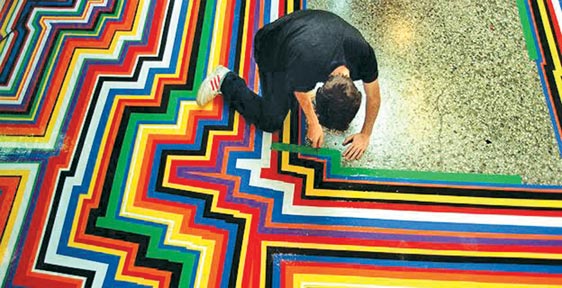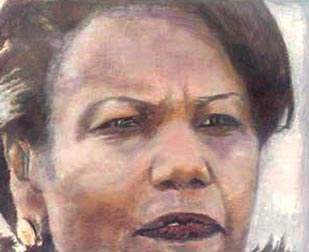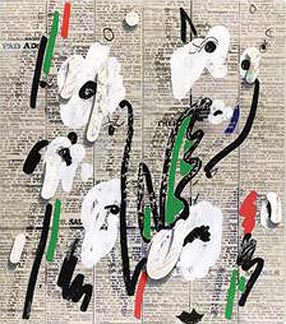No quite dead, not quite alive
Painting's obituary has been written several times
over the past 150 years. But it's now experiencing a major revival,
writes BBC's Jason Farago. :
|

Jim Lambie’s painting installation Zobop (Tom Pilston/The
Independent/REX) |
Something funny has been happening with painting lately - it seems in
terrible shape and yet also in better health than ever. The endless boom
of the art market, which privileges painting and especially abstraction,
has given us a new generation of 'zombie formalists', churning out safe,
easily sellable pictures that look good in digital reproduction and in
the booths of ever-multiplying art fairs.
And yet, beyond the frenzied market scene, the art of painting seems
to be thriving. Biennials that used to contain nothing but video and
installations now bulge with not just abstraction but also figurative
painting - last year's Gwangju Biennale in Korea was a feast of
representational art.
Is painting healthy or sick? And why is it so hard to tell? The
Forever Now, a divisive show of contemporary painting at the Museum of
Modern Art (MoMA) in New York, argues that painting is as healthy as
it's ever been - it just isn't interested in being novel anymore, and
instead recycles or redeploys pre-existing styles for new purposes.
Whether or not that argument convinces you or not (it didn't convince
me), the very fact that MoMA has organised a contemporary painting show
for the first time since 1984 attests that the stakes of painting are
higher than they've been for a while.
Painting Now, a new book by the art historian Suzanne Hudson, takes a
much deeper and more historical look at the status of contemporary
painting than MoMA's The Forever Now. It takes in the work of more than
200 artists, and yet it's much more than the usual coffee-table survey.
Hudson shrewdly looks away from style as she assesses the state of
painting, and instead insists that "a painting [be] tested or evaluated
relative to the history and tradition of the medium".
That gives her the welcome freedom to think not only about paintings
themselves, but about their motives, their production and distribution,
their framing and their institutions.
It also means that, unlike many fans of painting happy to brush away
recent history, Hudson dives headfirst into the choppy waters of
painting's status among the arts.
Twin blows
Painting has been declared dead so many times over the past 150 years
that it can be hard to keep track. But in her introduction, Hudson
pinpoints two developments in the history of art that shook painting to
its foundations, in both cases almost fatally. One was the invention of
photography in the 1830s. Photographs did more than just depict the
world better and faster than painting; they also made entire painterly
languages defunct, from military painting to academic portraiture.
("From today, painting is dead," the academic painter Paul Delaroche is
purported to have said after seeing a daguerreotype for the first time.)
Ever since, painting has in some ways functioned in dialogue with the
camera.
|

Luc Tuymans, The Secretary of State, 2005
(Alamy/Courtesy David Zwirner, New York/London) |
In some cases that dialogue takes the form of rejecting photographic
realism, such as in the unnatural colour of Van Gogh. Or the dialogue is
between equal partners. That can be via the use of silkscreened imagery,
most famously by Andy Warhol; via a hyperrealism of Richard Estes or
Franz Gertsch, whose paintings are 'more photographic' than photographs;
or via more painterly effects that nevertheless advertise their
photographic source, as in the art of Gerhard Richter and Chuck Close.
After photography, the other body blow to the primacy of painting
came in the 1910s, when Marcel Duchamp elevated a bicycle wheel, a
bottle rack and an upturned urinal to the status of art.
Even more than photography, the ready-made object struck at the heart
of painting's self-justification. Not only did Duchamp recalibrate the
terms of artistic success, privileging ideas over visuals. He also
eliminated the need for the artist's hand in a way photography never
entirely did. (Indeed, many photographers of the early 20th Century,
from Ansel Adams to Edward Steichen, consciously imitated painting
techniques.) Duchamp's insurrection removed technical skill as a
painterly virtue, and by the 1960s an artist like the minimalist
sculptor Donald Judd could confidently say, "It seems painting is
finished."
Some styles of painting really did undergo a kind of death in the
20th Century. So-called neo-expressionism, whose big bad canvases by
such figures as Julian Schnabel and Francesco Clemente fetched millions
in the 1980s, may have pleased the market but had little to offer anyone
who cared about the history and potential of the medium. Today's 'zombie
formalism' is much the same. But painting that acknowledges the
challenges the medium has faced and builds from there is doing very well
indeed. "Painting, too, is capable of manifesting its own signs," Hudson
writes. "Painting has become more, rather than less, viable after
conceptual art, as an option for giving idea form and hence for
differentiating it from other possibilities."
Premature burial
In the last century abstraction was seen as the supreme, even the
only, form of advanced painting. But in recent decades, as painting has
thrown off the yoke of avant-garde prescriptivism, figurative painting
has been on a noted upswing. Some make use of appropriated media
imagery, notably Luc Tuymans, whose colour-sapped paintings of
Condoleezza Rice or Patrice Lumumba redeploy photographic
representations. (Last month, he lost a plagiarism suit against the
photographer of one of the images he painted; he is appealing.) Others
prefer observation without cameras, such as Josephine Halvorson, who
paints modest tableaux of rural buildings from arm's length, or Liu
Xiaodong, whose plein-air paintings of young Chinese students recall
Manet and Courbet. Perhaps the biggest omission from Hudson's book is
Catherine Murphy, who is not only one of America's greatest painters but
also a professor who taught generations of students at Yale Art School.
|

Laura Owens, Untitled, 2013 (The Museum of Modern Art, NY.
Enid A Haupt Fund. Photo: Jonathan Muzikar) |
Painting has also moved off the canvas, and even off the walls. Imran
Qureishi, from Pakistan, makes not only miniature paintings but also
all-encompassing installations drawn directly on the floor and the
walls, often featuring blooming floral motifs in blood-red acrylic. Jim
Lambie plays off the architecture of the spaces in which he exhibits,
covering the floors with multi-coloured vinyl tape. Paintings also now
function frequently not as stand-alone artworks, but as elements of a
larger network of artistic procedures.
The influential painter Jutta Koether, for instance, does not only
paint; she also designs the presentation of her paintings, complete with
special lighting and ad hoc viewing platforms, and sometimes performs in
the gallery alongside them.
Koether's expansive practice of painting is a good counterweight to
the big question surrounding the rude health of the medium - a question
that goes unasked in Hudson's fine book. That is the question of the
market. When I visited her studio a few years ago, the artist RH
Quaytman - known for her brainy, reflexive paintings organised into
chapters, like a book - lamented how the demands of collectors and
markets were powerful enough to move art history. "Art fairs, jpegs and
the entire bloated art market are responsible for the resurgence of
painting as opposed to all other art forms," she told me.
"I'm sad that it is the structure of the art market that has
revalidated and reinvigorated painting.... It's easy to store, it's easy
to transport, it works well enough on the internet: it turned out that
painting was, despite itself, the perfect tool. The problem is, whose
tool is it?" Every painter should ask themself that question when they
turns to the empty canvas.
(This article was originally published in BBC Culture)
|

